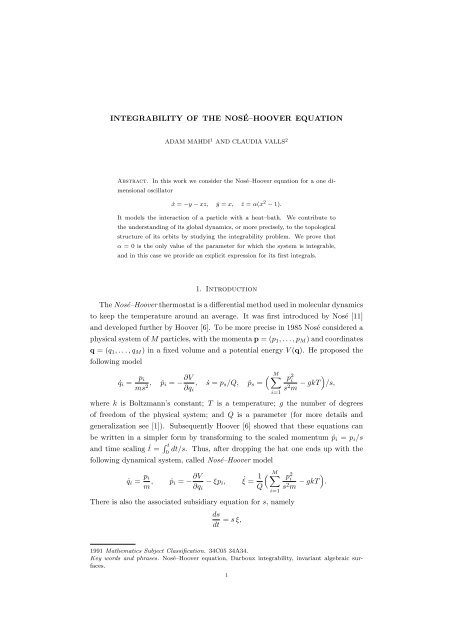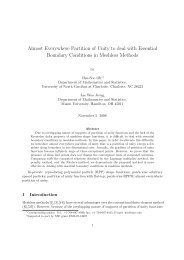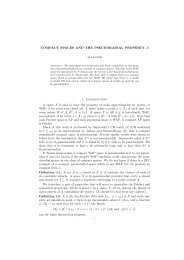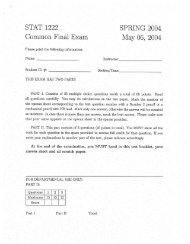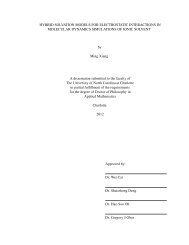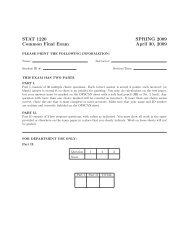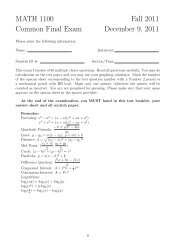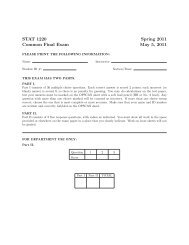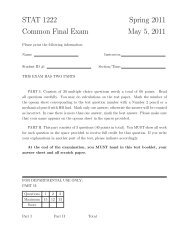INTEGRABILITY OF THE NOSÉ–HOOVER EQUATION 1 ...
INTEGRABILITY OF THE NOSÉ–HOOVER EQUATION 1 ...
INTEGRABILITY OF THE NOSÉ–HOOVER EQUATION 1 ...
You also want an ePaper? Increase the reach of your titles
YUMPU automatically turns print PDFs into web optimized ePapers that Google loves.
<strong>INTEGRABILITY</strong> <strong>OF</strong> <strong>THE</strong> <strong>NOSÉ–HOOVER</strong> <strong>EQUATION</strong><br />
ADAM MAHDI 1 AND CLAUDIA VALLS 2<br />
Abstract. In this work we consider the Nosé–Hoover equation for a one di-<br />
mensional oscillator<br />
˙x = −y − xz, ˙y = x, ˙z = α(x 2 − 1).<br />
It models the interaction of a particle with a heat–bath. We contribute to<br />
the understanding of its global dynamics, or more precisely, to the topological<br />
structure of its orbits by studying the integrability problem. We prove that<br />
α = 0 is the only value of the parameter for which the system is integrable,<br />
and in this case we provide an explicit expression for its first integrals.<br />
1. Introduction<br />
The Nosé–Hoover thermostat is a differential method used in molecular dynamics<br />
to keep the temperature around an average. It was first introduced by Nosé [11]<br />
and developed further by Hoover [6]. To be more precise in 1985 Nosé considered a<br />
physical system of M particles, with the momenta p = (p1, . . . , pM ) and coordinates<br />
q = (q1, . . . , qM ) in a fixed volume and a potential energy V (q). He proposed the<br />
following model<br />
˙qi = pi<br />
ms2 , ˙pi = − ∂V<br />
M<br />
p<br />
, ˙s = ps/Q, ˙ps =<br />
∂qi<br />
i=1<br />
2 i<br />
s2 <br />
− gkT /s,<br />
m<br />
where k is Boltzmann’s constant; T is a temperature; g the number of degrees<br />
of freedom of the physical system; and Q is a parameter (for more details and<br />
generalization see [1]). Subsequently Hoover [6] showed that these equations can<br />
be written in a simpler form by transforming to the scaled momentum ˆpi = pi/s<br />
and time scaling ˆt = t<br />
dt/s. Thus, after dropping the hat one ends up with the<br />
0<br />
following dynamical system, called Nosé–Hoover model<br />
˙qi = pi<br />
m , ˙pi = − ∂V<br />
− ξpi,<br />
∂qi<br />
ξ ˙<br />
1<br />
M<br />
p<br />
=<br />
Q<br />
i=1<br />
2 i<br />
s2 <br />
− gkT .<br />
m<br />
There is also the associated subsidiary equation for s, namely<br />
ds<br />
= s ξ,<br />
dt<br />
1991 Mathematics Subject Classification. 34C05 34A34.<br />
Key words and phrases. Nosé–Hoover equation, Darboux integrability, invariant algebraic surfaces.<br />
1
2 ADAM MAHDI 1 AND CLAUDIA VALLS 2<br />
which is not needed to compute the trajectories of the M interacting particles. Since<br />
then, this model attracted much attention, see for instance [3, 10, 4, 1, 7, 12, 8],<br />
where a number of its mathematical and physical aspects were studied.<br />
In this work we consider the Nosé–Hoover equation in the following form [6]:<br />
(1) ˙x = −y − xz, ˙y = x, ˙z = α(x 2 − 1),<br />
where α = 1/Q is a real parameter and renamed variables are x = p, y = q and<br />
z = ξ. This system is also called Nosé–Hoover equation for a one dimensional<br />
oscillator. A number of the dynamic aspects of system (1) have been analysed.<br />
In [6] Hoover integrates it numerically for α = 1 and α = 10. Later Hamilton [4]<br />
shows numerically a transition to large–scale irregular dynamics for limited range<br />
of α. Periodic orbits for this equation that emerge in bifurcations from heteroclinic<br />
cycles have recently been considered by Swinnerton–Dyer and Wagenknecht [12].<br />
We also note, that system (1) is a particular case of the well–known Hide, Skeldon<br />
and Acheson dynamo model [5].<br />
Here we further contribute to the understanding of the complexity, or more pre-<br />
cisely of the topological structure of the dynamics of system (1) by studying its<br />
integrability. For the three dimensional system of differential equations the exis-<br />
tence of one first integral reduces the complexity of its dynamics and the existence of<br />
two first integrals that are functionally independent solves completely the problem<br />
(at least theoretically) of determining its phase portraits. In general for a given dif-<br />
ferential system it is a difficult problem to determine the existence or non–existence<br />
of first integrals. Thus, for proving our main results we shall use the information<br />
about invariant algebraic surfaces of this system. This is the basis of the so called<br />
Darboux theory of integrability, for more details see Section 2.<br />
We first consider the case in which α = 0. We start with the following result.<br />
Theorem 1. The Nosé–Hoover equation with α = 0 is integrable with the following<br />
first integrals<br />
H1 = z and<br />
⎧<br />
⎪⎨ (x + y) exp<br />
H2 =<br />
⎪⎩<br />
y/(x + y)),<br />
(−2x + (−z +<br />
if z = 2,<br />
√ z2 − 4)y) λ2<br />
(2x + (z + √ z2 − 4)y) λ1<br />
, if z = 2<br />
where<br />
λ1 = 1<br />
2 (−z − z 2 − 4) and λ2 = 1<br />
2 (−z + z 2 − 4).<br />
It is straightforward to verify that H1 and H2 in the statement of the theorem<br />
are first integrals of the Nosé–Hoover equation when α = 0. Therefore the proof<br />
of Theorem 1 will be omitted and from now on we consider the case in which<br />
α ∈ R \ {0}.<br />
The following theorem is the main result of this paper.<br />
Theorem 2. The following statements hold for the Nosé–Hoover equation with<br />
α ∈ R \ {0}:
<strong>INTEGRABILITY</strong> <strong>OF</strong> <strong>THE</strong> <strong>NOSÉ–HOOVER</strong> <strong>EQUATION</strong> 3<br />
(a) It does not admit any polynomial first integral;<br />
(b) It does not admit any Darboux polynomial with nonzero cofactor;<br />
(c) Its only exponential factors are e y and e z2 +α(x 2 +y 2 ) with the cofactors x<br />
and −2αz, respectively;<br />
(d) It does not admit any Darboux first integral.<br />
The paper is organised as follows. In Section 2 we introduce some basic defini-<br />
tions and results related to the Darboux theory of integrability that we shall need<br />
in order to prove one of our main results. In Section 3 we prove Theorem 2.<br />
2. Preliminary results<br />
During recent years the interest in the study of integrability of differential equa-<br />
tions has attracted much attention. Darboux theory of integrability plays a central<br />
role in the integrability of the polynomial differential models. It gives a suffi-<br />
cient condition for the integrability inside the family of Darboux functions. More<br />
precisely, the significance of this method is that we can compute Darboux first in-<br />
tegrals by knowing a sufficient number of algebraic invariant surfaces (the so-called<br />
Darboux polynomials) and of the so-called exponential factors. We would like to<br />
highlight that it works for real or complex polynomial ordinary differential equa-<br />
tions. The study of complex invariant algebraic curves is necessary for obtaining<br />
all the real first integrals of a real polynomial differential equation, for more details<br />
see [9].<br />
We associate to system (1) the following vector field<br />
(2) X = (−y − xz) ∂ ∂<br />
+ x<br />
∂x ∂y + α(x2 − 1) ∂<br />
∂z .<br />
Let U ⊂ R 3 be an open subset. We say that the non–constant function H : U → R<br />
is a first integral of the polynomial vector field (2) associated to system (1), if<br />
H(x(t), y(t), z(t)) = constant for all values of t for which the solution (x(t), y(t), z(t))<br />
of X is defined on U. Clearly H is a first integral of X on U if and only if XH = 0<br />
on U. When H is a polynomial we say that H is a polynomial first integral.<br />
Let h = h(x, y, z) ∈ C[x, y, z] be a non–constant polynomial. We say that h = 0<br />
is an invariant algebraic surface of the vector field X in (2) if it satisfies Xh = Kh,<br />
for some polynomial K = K(x, y, z) ∈ C[x, y, z], called the cofactor of h. Note that<br />
K has degree at most 1. The polynomial h is called a Darboux polynomial, and<br />
we also say that K is the cofactor of the Darboux polynomial h. We note that a<br />
Darboux polynomial with a zero cofactor is a polynomial first integral.<br />
Let g, h ∈ C[x, y, z] be coprime. We say that a non–constant function E = e g/h<br />
is an exponential factor of the vector field X given in (2) if it satisfies XE = LE,<br />
for some polynomial L = L(x, y, z) ∈ C[x, y, z], called the cofactor of E and having<br />
degree at most 1. Note that this relation is equivalent to<br />
(3) (−y − xz) ∂(g/h)<br />
∂x<br />
+ x∂(g/h)<br />
∂y + α(x2 − 1) ∂(g/h)<br />
= L.<br />
∂z
4 ADAM MAHDI 1 AND CLAUDIA VALLS 2<br />
For a geometrical and algebraic meaning of the exponential factors see [2].<br />
A first integral G of system (1) is called of Darboux type if it is of the form<br />
(4) G = f λ1<br />
1<br />
λp<br />
· · · fp E µ1<br />
1 · · · Eµq q ,<br />
where f1, . . . , fp are Darboux polynomials, E1, . . . , Eq are exponential factors and<br />
λj, µk ∈ C for j = 1, . . . , p, k = 1, . . . , q. For more information on the Darboux<br />
theory of integrability see, for instance, [9] and the references therein.<br />
For a proof of the next proposition see [2].<br />
Proposition 3. The following statements hold:<br />
(a) If E = e g/h is an exponential factor for the polynomial system (1) and h is<br />
not a constant polynomial, then h = 0 is an invariant algebraic curve.<br />
(b) Eventually e g can be an exponential factor, coming from the multiplicity of<br />
the infinite invariant straight line.<br />
3. Proof of Theorem 2<br />
We separate the proof of Theorem 2 into different propositions.<br />
Proposition 4. System (1) with α ∈ R \ {0} does not admit a polynomial first<br />
integral.<br />
Proof. Let h be a polynomial first integral of system (1). Then it satisfies<br />
(5) (−y − xz) ∂h<br />
+ x∂h<br />
∂x ∂y + α(x2 − 1) ∂h<br />
= 0.<br />
∂z<br />
Without loss of generality we can write<br />
n<br />
(6) h = hj(x, y, z),<br />
j=1<br />
where each hj = hj(x, y, z) is a homogeneous polynomial of degree j and we assume<br />
that hn = 0.<br />
Computing the terms of degree n + 1 in (5) we get<br />
(7) −xz ∂hn<br />
∂x<br />
+ αx2 ∂hn<br />
∂z<br />
= 0.<br />
Solving this differential equation we obtain hn = hn[(αx 2 + z 2 )/2]. Since hn = 0 is<br />
a homogeneous polynomial of degree n ≥ 1, we conclude that n must be even and<br />
hn = αn(αx 2 + z 2 ) n/2 .<br />
Computing the terms of degree n in (5) we get<br />
(8) −y ∂hn<br />
∂x<br />
+ x∂hn<br />
∂y<br />
− xz ∂hn−1<br />
∂x<br />
Solving it with respect to hn−1 we obtain<br />
+ αx2 ∂hn−1<br />
∂z<br />
= 0.<br />
hn−1 = ±αnnα 1/2 y(αx 2 + z 2 ) n/2−1 arctan α1/2 x<br />
|z| + cn−1[(αx 2 + z 2 )/2],
<strong>INTEGRABILITY</strong> <strong>OF</strong> <strong>THE</strong> <strong>NOSÉ–HOOVER</strong> <strong>EQUATION</strong> 5<br />
where cn−1 is a homogeneous polynomial of the variable α(x 2 + z 2 )/2. Since hn−1<br />
is a homogeneous polynomial of degree n − 1 we conclude that<br />
±αnnα 1/2 y(αx 2 + z 2 ) n/2−1 = 0.<br />
Thus, since α = 0, we get that αn = 0 and consequently hn = 0, which is a<br />
contradiction with our assumption. This concludes the proof of the proposition. <br />
Proposition 5. System (1) with α ∈ R \ {0} does not admit any Darboux polyno-<br />
mial with nonzero cofactor.<br />
Proof. Let h be an irreducible Darboux polynomial of system (1) with nonzero<br />
cofactor K, where K = α0 + α1x + α2y + α3z, with αi ∈ C for i = 0, 1, 2, 3 not all<br />
zero.<br />
Then h satisfies<br />
(9) (−y − xz) ∂h<br />
+ x∂h<br />
∂x ∂y + α(x2 − 1) ∂h<br />
∂z = (α0 + α1x + α2y + α3z)h.<br />
It is easy to see by direct computations that h has degree greater or equal to two<br />
since system (1) has no Darboux polynomials of degree one with nonzero cofactor.<br />
Thus we decompose h as a sum of homogeneous polynomials similarly as in (6),<br />
where n ≥ 2 and hn = 0.<br />
Computing the terms of degree n + 1 in (9) we get<br />
−xz ∂hn<br />
∂x<br />
+ αx2 ∂hn<br />
∂z = (α1x + α2y + α3z)hn.<br />
Solving this linear differential equation we obtain<br />
<br />
hn =exp α −1/2 α1 arctan xα1/2<br />
|z| + yα2[log(α2xyA)−log(2A2 <br />
+2|z|A)]<br />
x<br />
A<br />
−α3 wn(v),<br />
where A = √ αx 2 + z 2 and wn(v) is a function of the variable v = (αx 2 + z 2 )/2.<br />
Since hn is a homogeneous polynomial of degree n and α = 0, we conclude that<br />
α1 = α2 = 0 and α3 = −m, where m is a nonnegative integer. Thus<br />
(10) hn = cnx m (αx 2 + z 2 ) p ,<br />
where p and m are nonnegative integers such that m + 2p = n and cn ∈ C \ {0}<br />
(since hn = 0).<br />
Computing the terms of degree n in (9) we get<br />
(11) −y ∂hn<br />
∂x<br />
+ x∂hn<br />
∂y<br />
− xz ∂hn−1<br />
∂x<br />
+ αx2 ∂hn−1<br />
∂z = α0hn − mzhn−1.<br />
Substituting (10) into equation (11) and solving it with respect to hn−1 we obtain<br />
hn−1 = cnx m A 2p−2<br />
<br />
3 α0xA<br />
α0A log[2A(A+|z|)]+α0A log<br />
2<br />
− 2pyα1/2 arctan xα1/2<br />
<br />
|z|<br />
+ cnmx m−1 yA 2p−2 |z| + x m wn−1(v),<br />
where wn−1(v) is a function of the variable v = (αx 2 + z 2 )/2. Since α = 0, cn = 0<br />
and hn−1 is a homogeneous polynomial of degree n−1, we get the conditions p = 0,
6 ADAM MAHDI 1 AND CLAUDIA VALLS 2<br />
α0 = 0, m − 1 ≥ 0 and 2p − 2 ≥ 0 which are clearly incompatible. This concludes<br />
the proof of the proposition. <br />
Proposition 6. The only exponential factors of system (1) with α ∈ R \ {0} are<br />
e y and e z2 +α(x 2 +y 2 ) with the cofactors x and −2αz, respectively.<br />
Proof. It follows from Proposition 3 that we can write E = e g and g satisfies<br />
(12) (−y − xz) ∂g ∂g<br />
+ x<br />
∂x ∂y + α(x2 − 1) ∂g<br />
∂z = (α0 + α1x + α2y + α3z),<br />
where αi ∈ C, for i = 0, 1, 2, 3 are not all zero.<br />
We first prove that g is a polynomial of degree two. We proceed by contradiction.<br />
Assume that g is polynomial of degree n ≥ 3. We write it as a sum of its homoge-<br />
neous parts as in equation (6) with hj replaced by gj. Without loss of generality<br />
we can assume that gn = 0. Then since the right–hand side of equation (12) has<br />
degree at most one, computing the terms of degree n + 1 in equation (12) we get<br />
−xz ∂gn<br />
∂x<br />
+ αx2 ∂gn<br />
∂z<br />
= 0,<br />
which is equation (7) replacing hn by gn. Then the arguments used in the proof<br />
of Proposition 4 imply that n must be even and gn must be of the form gn =<br />
αn(αx 2 + z 2 ) n/2 with αn ∈ C \ {0}.<br />
Now computing the terms of degree n ≥ 3 in (12) and taking into account that<br />
the right–hand side of (12) has degree one, we get equation<br />
−y ∂gn<br />
∂x<br />
+ x∂gn<br />
∂y<br />
− xz ∂gn−1<br />
∂x<br />
+ αx2 ∂gn−1<br />
∂z<br />
= 0,<br />
which is equation (8) with hn replaced by gn and hn−1 replaced by gn−1. The<br />
arguments used in the proof of Proposition 4 imply that gn = 0. Then we have<br />
that gn = 0 for n ≥ 3, and thus, g is a polynomial of degree at most two satisfying<br />
(12). Solving now (12) we get that g can be either y with cofactor x or z 2 +α(x 2 +y 2 )<br />
with cofactor −2αz and the proposition follows. <br />
3.1. Proof of Theorem 2. Statements (a), (b) and (c) in the theorem follow<br />
directly from Propositions 4, 5 and 6, respectively. In what follows we prove the<br />
statement (d) by contradiction. Assume that G is a first integral of Darboux type.<br />
Then in view of its definition in (4) and taking into account Propositions 4, 5 and<br />
6, G must be of the form<br />
G = e µ1x+µ2[z2 +α(x 2 +y 2 )] , with µ1, µ2 ∈ C.<br />
Since G is a first integral it must satisfy XG = 0, that is,<br />
Hence,<br />
XG = (−y − xz) ∂G<br />
+ x∂G<br />
∂x ∂y + α(x2 − 1) ∂G<br />
∂z<br />
= (µ1x − 2µ2αz)G = 0.<br />
µ1x − 2µ2αz = 0,
<strong>INTEGRABILITY</strong> <strong>OF</strong> <strong>THE</strong> <strong>NOSÉ–HOOVER</strong> <strong>EQUATION</strong> 7<br />
and since α = 0, this implies µ1 = µ2 = 0. Then G = constant, in contradiction<br />
with the fact that G was a first integral. This concludes the proof of the theorem.<br />
Acknowledgements<br />
The second author is partially supported by FCT through CAMGDS, Lisbon.<br />
References<br />
[1] A.C. Brańka and K.W. Wojciechowski, Generalization of Nosé and Nosé-Hoover isothermal<br />
dynamics, Phys. Rev. E 62 (2000), 3281–3292.<br />
[2] C. Christopher, J. Llibre, and J.V. Pereira, Multiplicity of invariant algebraic curves in<br />
polynomial vector fields, Pacific J. Math. 229 (2007), 63–117.<br />
[3] D.J. Evans and B.L. Holian, The Nose–Hoover thermostat, The Journal of Chemical Physics<br />
83 (1985), 4069–4074.<br />
[4] I. Hamilton, Nosé equation for a one–dimensional oscilator: Resonance zones and the tran-<br />
sition to large–scale irregular dynamics, Phys. Rev. E 38 (1988), 3120–2123.<br />
[5] R. Hide, A.C. Skeldon, and D.J Acheson, A study of two novel self–exciting single-disc<br />
homopolar dynamos: theory, Proc. R. Soc. London Ser. A 452 (1996), 1369–1395.<br />
[6] W.G. Hoover, Canonical dynamics: Equilibrium phase-space distributions, Phys. Rev. A 31<br />
(1985), 1695–1697.<br />
[7] F. Legoll, M. Luskin, and R. Moeckel, Non-ergodicity of the Nosé-Hoover thermostatted<br />
harmonic oscillator, Arch. Ration. Mech. Anal. 184 (2007), 449–463.<br />
[8] , Non-ergodicity of Nosé-Hoover dynamics, Nonlinearity 22 (2009), 1673–1694.<br />
[9] J. Llibre, Integrability of polynoial differential systems, Handbook of Differential Equations,<br />
Ordinary Differential Equations, Eds. A. Cañada, P. Drabek and A. Fonda, 1 (2004), 437–533.<br />
[10] H.A. Posch, W.G. Hoover, and F.J. Vesely, Canonical dynamics of the Nosé oscillator: sta-<br />
bility, order, and chaos, Phys. Rev. A (3) 33 (1986), no. 6, 4253–4265.<br />
[11] Nosé S., A unified formulation of the constant temperature molecular dynamics methods, J.<br />
Chem. Phys. 81 (1984), 511–519.<br />
[12] P. Swinnerton-Dyer and T. Wagenknecht, Some third-order ordinary differential equations,<br />
Bull. Lond. Math. Soc. 40 (2008), 725–748.<br />
1 Mathematics Department, University of North Carolina at Charlotte, Charlotte,<br />
North Carolina 28223, USA<br />
E-mail address: adam.mahdi@uncc.edu<br />
Faculty of Applied Mathematics, AGH University of Science and Technology, al.<br />
Mickiewicza 30, 30-059 Kraków, Poland<br />
2 Departamento de Matemática, Instituto Superior Técnico, Av. Rovisco Pais 1049-<br />
001, Lisboa, Portugal<br />
E-mail address: cvalls@math.ist.utl.pt


